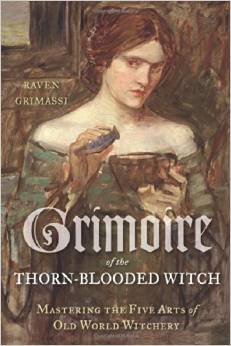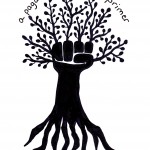Raven Grimassi describes this book as an attempt to codify or distill what he calls the “roots” of Old World witchcraft: “The magical tradition presented in this book is ever ancient and ever new.” That is to say, he is presenting a “cohesive system” of magic based on his own experiences in Witchcraft and some encounters with various plant spirits as teachers, and asserts that this kind of direct relationship with otherworldly beings and what he calls “the magic of the Greenwood” is where witchcraft originally came from anyway.
So far, so promising. I am in agreement with this idea in principle. I have some reservations about the execution of it here, which may be a matter of taste. My biggest objection is that I don’t think it’s actually possible to uncouple witchcraft and magic from culture…we humans are cultural beings, it’s what we do, our evolutionary gig as it were, and it shapes our thinking in all things will-we or nil-we. Attempting to sidestep the problem doesn’t tend to solve it, in my experience. I also think that human culture as an aggregate is far richer and more complex than what any one individual can produce (that, after all, is its purpose) and therefore that by attempting to universalize you are apt to lose a great deal in translation. That isn’t to say that there are not connections to be made, and Raven Grimassi describes the experience of moving from a very culturally-identified practice to a more universal one as transformative and deepening. I don’t dispute that it worked that way for him; my concern here is that a beginner will find that the lack of grounding in culture, history, or a community of practitioners is an obstacle to moving past the beginner stage. Since this is a book meant to start people on a deeper path, I see that as a problem.
On the other hand, the book does provide some advantages which many other books suitable for beginners lack. Though Grimassi is careful to point out that the system presented in this book does not fit the definition of “Traditional Witchcraft,” he does say that there are strong similarities. I would be more inclined to describe the relationship as “mostly unacknowledged influence” but I am cranky about such things. In any case, one big virtue of Grimoire of the Thorn-Blooded Witch is that it is the closest thing to an accessible, usable primer or introduction to Traditional Witchcraft I have seen. It’s certainly far more readable than books on Traditional Witchcraft generally are. A beginner who doesn’t have a teacher from an actual TW lineage handy, or who wants to get the feel of it before going deeper, would probably find this book useful. I would recommend supplementing with some solid history (by which I mean books written by actual historians), folklore, and older source material on witchcraft to balance its flaws.
And it does have flaws. One is the tendency to use sweeping declarations and passive voice (“In Old World Witchery this is known as…”) which tend to obscure the source of the ideas; it’s hard therefore to know where Grimassi is coming from or to orient oneself in them. Another and more serious one is that the reader is directed to start working with plant spirits by establishing a blood-pact with “She of the Thorn-Blooded Rose” without any previous contact, meditations, or connections. (Those come after). This strikes me as the spirit-work equivalent of a bar hookup. As that is more or less how I met my ex-husband…well, it wasn’t so much a bar as a science fiction convention…I can’t say it’s always a disaster. But I will say that like most twenty-year-olds I was notably lacking in common sense. And while we did wind up getting married, we also wound up getting divorced. What I’m saying is, you are taking your chances and maybe it would be better to sit down with this Thorn-Blooded She and have a nice chat and some tea. Get to know each other first. I personally would do the work with the recommended sigil and rose, etc. first and then try to establish a closer connection, which reverses the order in the book.
Verdict: Worth reading if you are a beginner, but don’t rely on it by itself. And exercise some prudence.

















